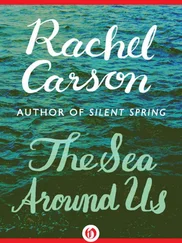Rachel Carson - The Edge of the Sea
Здесь есть возможность читать онлайн «Rachel Carson - The Edge of the Sea» весь текст электронной книги совершенно бесплатно (целиком полную версию без сокращений). В некоторых случаях можно слушать аудио, скачать через торрент в формате fb2 и присутствует краткое содержание. Город: Boston, Год выпуска: 1998, ISBN: 1998, Издательство: Mariner Books, Жанр: Биология, sci_ecology, sci_popular, на английском языке. Описание произведения, (предисловие) а так же отзывы посетителей доступны на портале библиотеки ЛибКат.
- Название:The Edge of the Sea
- Автор:
- Издательство:Mariner Books
- Жанр:
- Год:1998
- Город:Boston
- ISBN:978-0-395-07505-0
- Рейтинг книги:4 / 5. Голосов: 1
-
Избранное:Добавить в избранное
- Отзывы:
-
Ваша оценка:
- 80
- 1
- 2
- 3
- 4
- 5
The Edge of the Sea: краткое содержание, описание и аннотация
Предлагаем к чтению аннотацию, описание, краткое содержание или предисловие (зависит от того, что написал сам автор книги «The Edge of the Sea»). Если вы не нашли необходимую информацию о книге — напишите в комментариях, мы постараемся отыскать её.
A book to be read for pleasure as well as a practical identification guide,
introduces a world of teeming life where the sea meets the land. A new generation of readers is discovering why Rachel Carson’s books have become cornerstones of the environmental and conservation movements. New introduction by Sue Hubbell.
The Edge of the Sea — читать онлайн бесплатно полную книгу (весь текст) целиком
Ниже представлен текст книги, разбитый по страницам. Система сохранения места последней прочитанной страницы, позволяет с удобством читать онлайн бесплатно книгу «The Edge of the Sea», без необходимости каждый раз заново искать на чём Вы остановились. Поставьте закладку, и сможете в любой момент перейти на страницу, на которой закончили чтение.
Интервал:
Закладка:
The stands of sea tangles and long-stalked laminarias are, in their way, an Atlantic counterpart of the great submarine jungles of the Pacific, where the kelps rise like giant forest trees, 150 feet from the floor of the sea to the surface.
On all rocky coasts, this laminarian zone just below low water has been one of the least-known regions of the sea. We know little about what lives here throughout the year. We do not know whether some of the forms that disappear from the intertidal area in winter may merely move down into this zone. And perhaps some of the species we think have died out in a particular region, perhaps because of temperature changes, have gone down among the Laminarias. The area is obviously difficult to explore, with heavy seas breaking there most of the time. Such an area on the west coast of Scotland was, however, explored by helmet divers working with the British biologist, J. A. Kitching. Below the zone occupied by Alaria and the horsetail kelp, from about two fathoms below low water and beyond, the divers moved through a dense forest of the larger Laminarias. From the vertical stipes an immense canopy of fronds was spread above their heads. Although the sun shone brightly at the surface, the divers were almost in darkness as they pushed through this forest. Between three and six fathoms below low water of the spring tides the forest opened out, so that the men could walk between the plants without great difficulty. There the light was stronger, and through misty water they could see this more open “park” extending farther down the sloping floor of the sea. Among the holdfasts and stipes of the laminarias, as among the roots and trunks of a terrestrial forest, was a dense undergrowth, here formed of various red algae. And as small rodents and other creatures have their dens and runways under the forest trees, so a varied and abundant fauna lived on and among the holdfasts of the great seaweeds.
In quieter waters, protected from the heavy surf of coasts that face the open ocean, the seaweeds dominate the shore, occupying every inch of space that the conditions of tidal rise and fall allow them and by the sheer force of abundant and luxuriant growth forcing other shore inhabitants to accommodate to their pattern.
Although the same bands of life are spread between the tide lines whether the coast be open or sheltered, in their relative development the zones vary greatly on the two types of shore.
Above the high-tide line there is little change and on the shores of bays and estuaries, as elsewhere, the microplants blacken the rocks and the lichens come down and tentatively approach the sea. Below high water of spring tides, pioneering barnacles trace occasional white streaks in token occupation of the zone they dominate on open coasts. A few periwinkles graze on the upper rocks. But on sheltered coasts the whole band of shore marked out by the tides of the moon’s quarters is occupied by a swaying submarine forest, sensitive to the movements of the waves and the tidal currents. The trees of the forest are the large sea weeds known as the rockweeds or sea wracks, stout of form and rubbery of texture. Here all other life exists within their shelter—a shelter so hospitable to small things needing protection from drying air, from rain, and from the surge of the running tides and the waves, that the life of these shores is incredibly abundant.

When covered at high tide, the rockweeds stand erect, rising and swaying with a life borrowed from the sea. Then, to one standing at the edge of a flooding tide, the only sign of their presence may be a scattering of dark patches on the water close inshore, where the tips of the weeds reach up to the surface. Down below those floating tips small fishes swim, passing between the weeds as birds fly through a forest, sea snails creep along the fronds, and crabs climb from branch to branch of the swaying plants. It is a fantastic jungle, mad in a Lewis Carroll sort of way. For what proper jungle, twice every twenty-four hours, begins to sag lower and lower and finally lies prostrate for several hours, only to rise again? Yet this is precisely what the rockweed jungles do. When the tide has retreated from the sloping rocks, when it has left the miniature seas of the tide pools, the rockweeds lie flat on the horizontal surfaces in layer above layer of sodden, rubbery fronds. From the sheer rock faces they hang down in a heavy curtain, holding the wetness of the sea, and nothing under their protective cover ever dries out.
By day the sunlight filters through the jungle of rockweeds to reach its floor only in shifting patches of shadow-flecked gold; by night the moonlight spreads a silver ceiling above the forest—a ceiling streaked and broken by the flowing tide streams; beneath it the dark fronds of the weeds sway in a world unquiet with moving shadows.
But the flow of time through this submarine forest is marked less by the alternation of light and darkness than by the rhythm of the tides. The lives of its creatures are ruled by the presence or absence of water; it is not the fall of dusk or the coming of dawn but the turn of the tide that brings transforming change to their world.
As the tide falls the tips of the weeds, lacking support, float out horizontally across the surface. Then the cloud shadows darken and a deepening gloom settles over the floor of the forest. As the overlying layer of water thins and gradually drains away, the weeds, still stirring, still responsive to each pulsation of the tide, drift closer to the rock floor and finally lie prostrate upon it, all their life and movement in abeyance.
By day an interval of quiet settles over the jungles of the land, when the hunters lie in their dens, and the weak and the slow hide from the daylight; so on the shore a waiting lull comes with every ebbing of the tide.
The barnacles furl their nets and swing shut the twin doors that exclude the drying air and hold within the moisture of the sea. The mussels and the clams withdraw their feeding tubes or siphons and close their shells. Here and there a starfish, having invaded the forest from below on the previous high tide and incautiously lingered, still clasps a mussel within its sinuous arms, gripping the shells with the sucker-tipped ends of scores of slender tube feet. Pushing under and among the horizontal fronds of the weed, as a man would make his way with difficulty through trees blown down by a storm, a few crabs are active, digging their little slanting pits to expose the clams buried in the mud. Then they crack away pieces of shell with their heavy claws, while they hold the clam in the tips of the walking legs.
A few hunters and scavengers come down from the upper tidelands. The little gray-cloaked tide-pool insect, Anurida, wanders down from the upper shore and scurries over the rock floor, hunting out mussels with gaping shells, or dead fish, or fragments of crabs left by gulls. Crows walk about over the weeds; they sort them over strand by strand until they find a periwinkle hidden in the weed, or clinging to a rock that lies under the sodden cloak of the algae. Then the crow holds the shell in the strong toes of one foot, while with its beak it deftly extracts the snail.
The pulse of the returning tide at first beats gently. The advance during the beginning of the six-hour rise to high-water mark is slow, so that in two hours only a quarter of the intertidal zone has been covered. Then the pace of the water quickens. For the next two hours the tidal currents are stronger and the rising waters advance twice as far as in the first period; then again the tide slackens its pace for a leisurely advance over the upper shore. The rockweeds, covering the middle band of shore, receive the shock of heavier waves than the relatively bare shore above, yet their cushioning effect is so great that the animals that cling to them or live on the rock floor below them are far less affected by the surf than those of the upper rocks, or those of the zone below which experience all the heavy drag from the backwash of waves that break as the tide is advancing rapidly over the middle shore.
Читать дальшеИнтервал:
Закладка:
Похожие книги на «The Edge of the Sea»
Представляем Вашему вниманию похожие книги на «The Edge of the Sea» списком для выбора. Мы отобрали схожую по названию и смыслу литературу в надежде предоставить читателям больше вариантов отыскать новые, интересные, ещё непрочитанные произведения.
Обсуждение, отзывы о книге «The Edge of the Sea» и просто собственные мнения читателей. Оставьте ваши комментарии, напишите, что Вы думаете о произведении, его смысле или главных героях. Укажите что конкретно понравилось, а что нет, и почему Вы так считаете.












